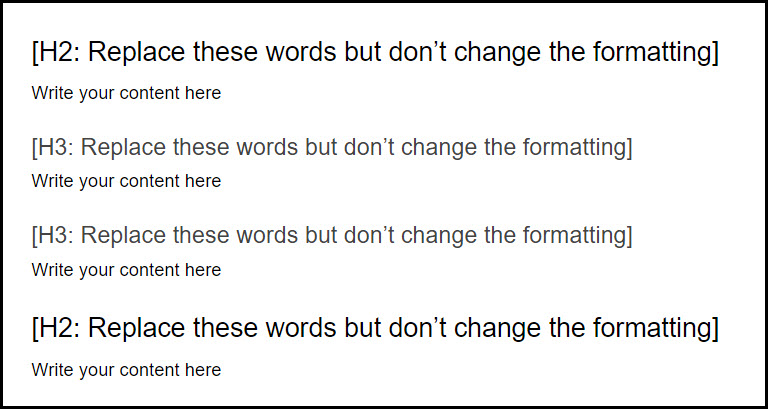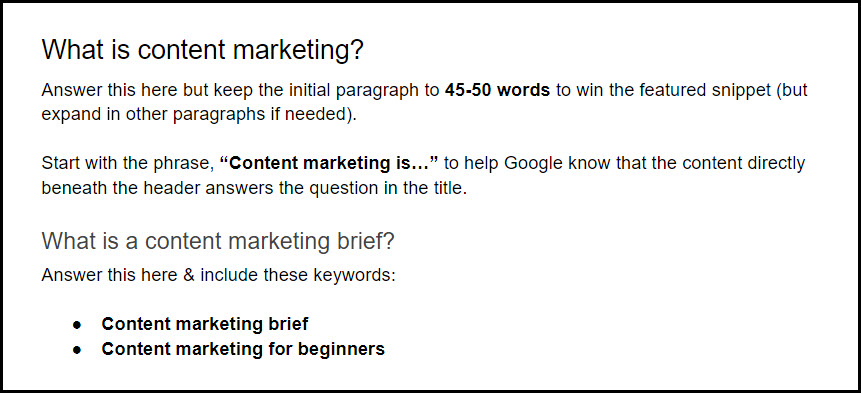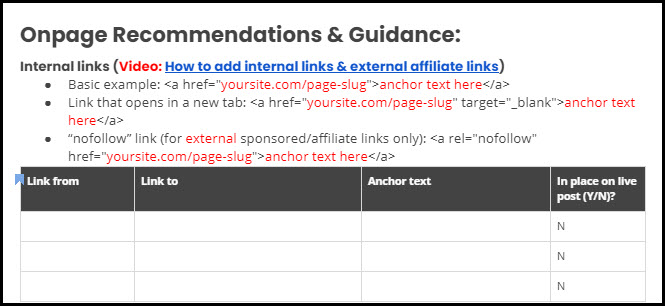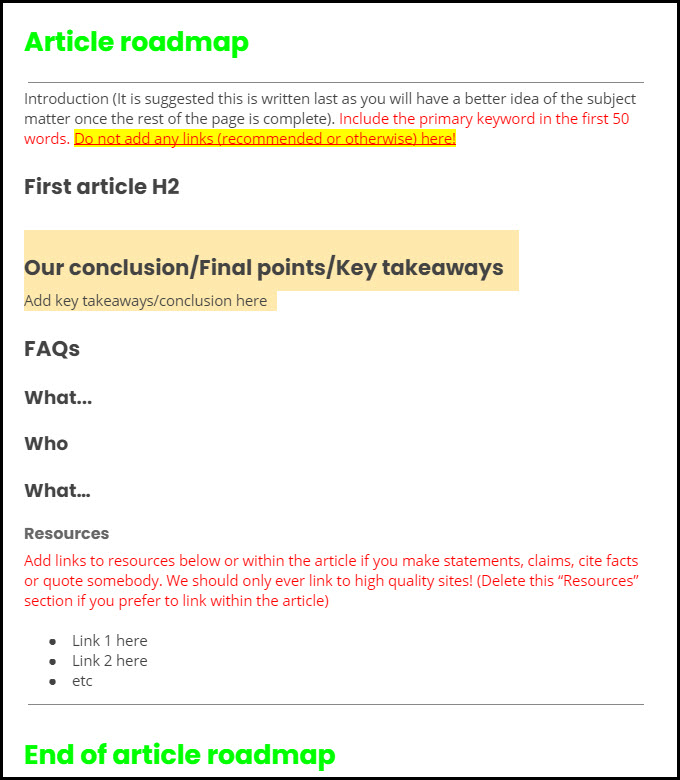Ah, content marketing… Isn’t it a beautiful beast?
Whether you love it or hate it, be in no doubt that it’s an essential part of your marketing strategy.
Did you know that 77% of companies have a content marketing strategy?

It even fits in the process of that joyous email outreach.—once you have the template nailed, you’ll have relevant and SEO-rich content ready for a guest post.
Not convinced?
Grab a cup of Joe and join me as we explore how a content brief template can bring deep joy (Marie Kondo, anyone?) to your life.
Table of Contents:
- Benefits of a content brief template
- What forms the base of a content brief template?
- Are you ready to level-up yet?
Benefits of a content brief template
Ever get so frustrated about someone else creating unnecessary work for you so bad that it makes you want to re-enact the Game of Thrones “Red Wedding”?
Yup… me too!!
But, one of the critical benefits of a content brief template is to remove the guesswork and provide your writer with everything they need to nail their content.
Note: The above also applies for B2B clients and whether you have an in-house writer or are outsourcing your content
In my experience, these are the main benefits that a content brief template can steamroll into your life:
- Remove bottlenecks & escalate content marketing efficiencies
- Manage expectations & remove guesswork
- Universal to anyone
- Deliver quick SEO wins
- Adaptable to any niche/industry
1. Remove bottlenecks & increase efficiency
Even if your content process is already clearly defined, you still need clearly defined templates for all stakeholders to create specific briefs for each piece of content.
I’ll go through what the bare bones should look like later, but can you just imagine how inefficient a process is with different staff having different methods to get the same result?
And, actually, the ideal “same result” is highly unachievable without a template to work off.
By investing time into a template NOW, you’ll save an insane amount of time going forward, and that also applies if you’re creating the briefs on your own.
All you’d need to do once the template’s created is:
- Open the template
- Make a copy & rename (see “the medium” section below)
- Complete each section
- Send to the writer
It’s really that simple!
Without the above four, simple steps, you’ll try to recreate each brief over and over again, essentially wrecking the “touch it once” rule, which FirstBase Employment summarizes well:

While she applies it to procrastination, it’s also relevant to productivity when on-task (thanks to Matt Foster):

2. Manage expectations & remove guesswork
Imagine asking someone to run off and create a bunch of content briefs, giving them no pointers or hints as to what’s needed.
What do you think you’ll get back?
- A jumbled mess?
- Something without direction?
- A lack of uniformity?
- An angry face?
Most likely all of the above!
And… you have ZERO ground to go back with, “That’s not what I wanted, Steve!”
By including the sections I talk about further down, you get the chance to lay out all your expectations from the very beginning, removing any kind of guesswork for anyone involved in creating a content brief.
3. Universal to anyone
Our pals over at the Content Marketing Institute surveyed that 32% of B2B marketers don’t employ a full-time in-house person solely dedicated to content marketing.

That’s both scary and also understandable. Content marketing isn’t an easy beast to take on, especially since it’s still a new area of expertise.
BUT, this is where we can minimize the impact of the statistic by making a content brief template universal to anyone… even if they aren’t a writer.
Yep, you heard me…
Sometimes, writers think they know best (of course we do :)), and may just run off down a rabbit hole without disregard for the brief.
BUT, an in-house staff member who also writes is more likely to follow the template’s guidance and deliver exactly what’s needed.
Remember the above because not wandering from the brief plays an important role in SEO…
4. Quick SEO wins
This applies to any writer, no matter:
- Their skill level,
- Knowledge,
- Whether they’re a freelancer, an in-house team member or if they have pineapple on their pizza (yum!!)
Let’s assume you have in-house staff who can write.
Which of these templates do you think will provide the best results?
Exhibit 1: Vague and mundane (has had a bad morning and hates the writer)

Exhibit 2: Optimized for SEO (is caring, intelligent and wants the writer to succeed)

It’s pretty obvious which is easier for the writer.
Exhibit 1, of course!
Yea, right… perhaps if you really want to cause roadblocks and not help your writer.
Remember: While the original template is likely to be more aligned to exhibit 1, it should be tailored each time for each piece of content—see my example screenshots below.
Doing so will ensure the writer doesn’t reinvent the wheel, but the only caveat is that you need someone who knows what they’re doing SEO-wise.
Sure, you can combine a bunch of essential SEO tools to nail this, but just ensure you walk the fine balance between not doing the work for them. They still need to earn their daily bread.
And, one of the awesome things about this is that…
… drum roll, please…
… you can use it for ANY industry or topic!
5. Fully adaptable to an industry as you need
With only 11% of marketing-related setups not having an “excellent” content marketing strategy, it’s even more imperative that a content brief template be accessible for ALL industries.

A complete & structured template means any content marketer can pick up the template and repurpose it, no matter the:
- Client
- Industry
- Niche
- Topic
- Or what they had for dinner
The trick here is to make the original template bare-bones enough that the content marketer/SEO specialist/whoever just fills in the blanks and sends it on its way—more on this coming up!
For me, the key to success, though, is ensuring that your template includes everything needed to deliver maximum results.
I have first-hand experience on tailoring content briefs across the following:
- Industrial stairs
- Pond supplies & equipment
- Coffee eCommerce site
- Bulk bag manufacturers
And ALL the content briefs have come from the same, original content brief template.
So, all you B2B, digital and content marketers (or even bloggers) out there… no matter what you call yourselves…
… I urge you to consider implementing a content brief template as part of your content marketing strategy, pronto!
What forms the base of a content brief template?
I bet your minds are leaping around like crazy, trying to figure out what the hell one of these kick-ass templates should look like.
Well, it’s up to you, but there are some core fundamentals you need to consider:
- The medium
- The sections
- The person responsible
1. The medium
GOOGLE DOCS!
MS Word doesn’t even touch Google Docs, purely for:
- Being cloud-based
- Providing advanced access control
- Allowing individuals to organize their isolated drives
You can even incorporate it with Google Sheets to store a repository of different templates for different needs, such as:
- Generic template
- “How To” guides
- Recipes
- “Best” reviews
- X vs Y comparisons
Check this out as an example of how you can use Google Sheets with links to the relevant content brief template based on the type of content:

2. The content brief template sections
Naturally, what you include in your template is entirely your choice, but I find these as the core sections:
- Video instructions/guide
- Due date
- Word count target
- Target audience & tone of voice
- Title, meta description & H1
- Target keywords
- Competitors
- Internal links
- Roadmap
It may seem like a lot, but you can condense it all quite nicely into your template, as you’ll see from the below examples.
Video instructions/guide
SOPs are an integral part of any business process, and content brief templates form a powerful part of them.
Whether you have a dedicated folder for SOPs and include one on how to use the template is up to you, but I strongly recommend you have a link to the video at the top of the template:

That way, there’s no chance the writer can come back to you playing dumb, not knowing how to use the template.
Top tip: Go through EVERY section of the template in your video, holding the writer’s hand by explicitly saying what the intention of each section is.
Due date
I work on a monthly basis with clients, but if you have an issue with work going late regularly, perhaps use a specific date rather than something more broad to manage expectations.
As your internal process becomes smoother, look to be more lax on the due date. Otherwise, sending work late to the client (whether internal or external) is a big no-no!
Word count target
I’m desperately trying to avoid talking about “managing expectations” over and over…
…a bit like a parent saying to their kid, “I told you so!”
But, you’ll notice that a lot of the template is about clearly laying out what exactly it is you need from the content brief.
Word count is quite a contentious subject in my opinion, and there are arguments for and against smaller or larger volumes.
Ultimately, it depends on three things for me:
- Topic depth: If your content is to be a pillar or hub, then more words are naturally needed
- Competition: There’s no point thrashing out a 5k article if the competition is ranking well for multiple related keywords in a 1k article.
- Intent: Detailed step-by-step guides are more word-intensive than an image-heavy article focusing on design ideas.
Caveat: Don’t let the competition rule you, but use them as a yardstick. YOU are in control of your own content. If you can deliver the same result in fewer words, do so!
No matter your situation, if you don’t give the writer a word count target, you can’t complain that they’ve written too many or too few.
Target audience & tone of voice
Don’t keep your writer in the dark!
Use this section to guide them as to who the audience is. That way, they can tailor their writing style accordingly.
This will help improve CRO (conversion rate optimization) and click-through rates.
For example, you don’t want content full of idiosyncrasies, euphemisms and banter if you’re writing a white paper for a local government official—a slight exaggeration but it gets my point across.
Title, meta description & H1

Having this SEO-important information in the template means whoever uploads the content into your CMS can do so easily, from the same location as the content.
This is an important part of organizing your content marketing!
Top tip: If you’re creating briefs for a client, do the work for them and populate the title, meta description and H1
Target keywords
When isn’t it a good idea to include a list of the top keywords you want the content to rank for?
Having this dedicated section can work for both the individual responsible for the content marketing and the writer.
For the responsible dudette or dude, you can easily check to see if the focus keywords are included in these core areas:
- Meta title
- Meta description
- H1, H2 & H3
- Body content (preferably in the introduction, too!)
Depending on the article depth, it can be impossible to nail ALL the keywords, so try and trim the list down to 10 or so.
Top tip: Include the monthly search volume from a tool like Ahrefs (which is an awesome backlink tracker tool) as an easy reference to confirm which are the most important
Competitors
While I don’t believe you should ever curate content based on the competition, it’s still a good idea to know what they’re doing so you can emulate and then smash them out of the water.
When analyzing the competition, combine it with an SEO tool (such as Clearscope in the below example) that analyzes the competition for NLP (natural language processing).

In my example, it’s a simple and clear section to provide:
- Introductory video on how to use Clearscope
- Space for the Clearscope link
- URLs for competitors
Top tip: Only include competitor URLs that are highly relevant to you and that are written well. There’s a danger that a writer can emulate poorly written content
Internal links
While I wouldn’t use this section as the main location to track internal links, it serves well for the writer to drop in the internal links YOU decide.
We know that internal linking is an important strategy to grow traffic, so it’s really important you include this part of the template:

Why not add value and include some basic instructions, too?
You really don’t want this section to go pear-shaped, so get someone who’s responsible for and knowledgeable around yours or the client’s silo/hub and spoke structure to populate it.
Roadmap
This is where the writer will work their magic, so make it clear that this is the section for them.
While the introductory video at the very beginning will explain this, it’s still a good idea to make it glaringly obvious.
You can also add in any further information to serve as a nudge and give them some further guidance.
Note that the example below is a bare-bones template that I haven’t optimized for anything:

3. The responsible individual
Since there are so many different components of the content brief template, consider splitting responsibilities between:
- Content strategist: Creating the content brief each time
- Writer: Writing the content and nothing else
Why?
It allows the content strategist to fly like an eagle above the content marketing strategy with a clear vision of the holistic picture.
In doing so, the writer can purely focus on their creative talent.
Such a clear segregation of duties will also maximize efficiency and hone talent.
Note: There’s nothing to say you can’t blend the two; just ensure you track and remove efficiency roadblocks where necessary.
Are you ready to level-up yet?
You have everything you need to create your own content brief template now! Just ensure you tailor it to your needs.
Also remember that the intention of the template is to deliver long-term systemic improvements. The initial time resource to get it developed is totally worth it.
I wish you all the best in your content brief template journey. Enjoy the process and love the results!






